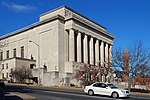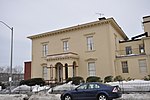Salisbury House (Worcester, Massachusetts)
Houses completed in 1838Houses in Worcester, MassachusettsHouses on the National Register of Historic Places in Worcester County, MassachusettsNational Register of Historic Places in Worcester, MassachusettsWorcester, Massachusetts Registered Historic Place stubs

The Salisbury House is an historic house at 61 Harvard Street in Worcester, Massachusetts. The Greek Revival building was constructed between 1836 and 1838 by Stephen Salisbury II, son of Worcester merchant Stephen Salisbury I whose 18th century mansion stands nearby. It was added to the National Register of Historic Places in 1975. The two-story wood-frame structure is finished in flushboarded wood treated to resemble stone. Design of the building is attributed either to Elias Carter or Isaiah Rogers (sources disagree).
Excerpt from the Wikipedia article Salisbury House (Worcester, Massachusetts) (License: CC BY-SA 3.0, Authors, Images).Salisbury House (Worcester, Massachusetts)
Lancaster Street, Worcester
Geographical coordinates (GPS) Address Nearby Places Show on map
Geographical coordinates (GPS)
| Latitude | Longitude |
|---|---|
| N 42.271944444444 ° | E -71.802222222222 ° |
Address
Highland Street Lot
Lancaster Street
01605 Worcester
Massachusetts, United States
Open on Google Maps











